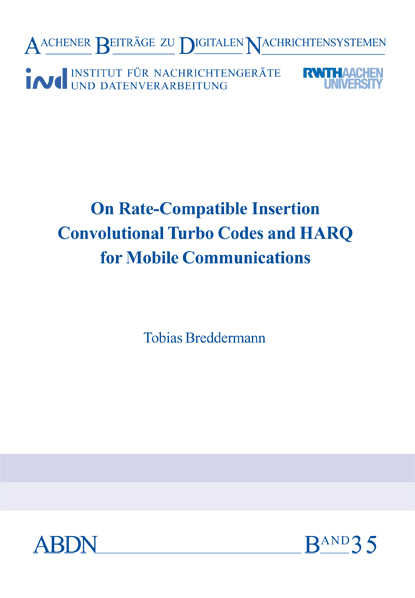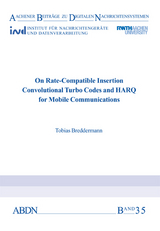On Rate-Compatible Insertion Convolutional Turbo Codes and HARQ for Mobile Communications
Seiten
- Keine Verlagsinformationen verfügbar
- Artikel merken
Rate-compatible Turbo codes are part of many mobile communication systems as, e.g., LTE. The code rate of a fixed-rate mother Turbo code is adapted by bit puncturing and bit repetition. While bit puncturing allows to flexibly increase the effective code rate by discarding a certain number of encoded bits, bit repetition facilitates lower effective code rates by duplicating a distinct number of encoded bits prior to transmission.
The first part of this thesis deals with dummy bit insertion, which is a high potential alternative to bit repetition. Lower code rates can be constructed by inserting known (dummy) bits into the information bit sequence before Turbo coding (referred to as Rate-Compatible Insertion Convolutional (RCIC) Turbo coding). Besides an improved frame error rate performance, a considerable convergence speedup is realized for LTE. These observations are also confirmed by means of their EXIT charts, which have been derived from the EXIT chart of the mother Turbo code using information theoretic models. Similar derivations are also given for Turbo coding with bit puncturing and bit repetition. In all cases, the obtained expressions result in novel semi-analytical rate matching procedures, which determine analytically the optimal code rate required for (nearly) error-free decoding at a specific target channel quality. A successful application of dummy bit insertion to Low-Density Parity-Check (LDPC) codes is also provided in this part.
The second part of the thesis focuses on Hybrid Automatic Repeat reQuest (HARQ). At first, a novel HARQ scheme for LTE based on bit puncturing and dummy bit insertion is proposed. Evaluations of the system throughput have proven that the novel system surpasses the standardized LTE HARQ system in a wide range of channel conditions. Then, HARQ with unreliable feedback is studied. Based on a general feedback channel model, analytical expressions for the overall system throughput are derived in dependence of the feedback error probabilities and the frame error rates of the HARQ system with reliable feedback. Extensive time consuming simulations of the HARQ system with unreliable feedback can, thus, be avoided.
Finally, Header bit Assisted Channel Decoding (HACD) is addressed. Upper bounds on the expected gains are determined analytically based on the EXIT chart analysis presented in the first part of this thesis.
The first part of this thesis deals with dummy bit insertion, which is a high potential alternative to bit repetition. Lower code rates can be constructed by inserting known (dummy) bits into the information bit sequence before Turbo coding (referred to as Rate-Compatible Insertion Convolutional (RCIC) Turbo coding). Besides an improved frame error rate performance, a considerable convergence speedup is realized for LTE. These observations are also confirmed by means of their EXIT charts, which have been derived from the EXIT chart of the mother Turbo code using information theoretic models. Similar derivations are also given for Turbo coding with bit puncturing and bit repetition. In all cases, the obtained expressions result in novel semi-analytical rate matching procedures, which determine analytically the optimal code rate required for (nearly) error-free decoding at a specific target channel quality. A successful application of dummy bit insertion to Low-Density Parity-Check (LDPC) codes is also provided in this part.
The second part of the thesis focuses on Hybrid Automatic Repeat reQuest (HARQ). At first, a novel HARQ scheme for LTE based on bit puncturing and dummy bit insertion is proposed. Evaluations of the system throughput have proven that the novel system surpasses the standardized LTE HARQ system in a wide range of channel conditions. Then, HARQ with unreliable feedback is studied. Based on a general feedback channel model, analytical expressions for the overall system throughput are derived in dependence of the feedback error probabilities and the frame error rates of the HARQ system with reliable feedback. Extensive time consuming simulations of the HARQ system with unreliable feedback can, thus, be avoided.
Finally, Header bit Assisted Channel Decoding (HACD) is addressed. Upper bounds on the expected gains are determined analytically based on the EXIT chart analysis presented in the first part of this thesis.
| Erscheint lt. Verlag | 13.1.2014 |
|---|---|
| Reihe/Serie | Aachener Beiträge zu Digitalen Nachrichtensystemen ; 35 |
| Sprache | englisch |
| Maße | 145 x 210 mm |
| Gewicht | 254 g |
| Einbandart | Paperback |
| Themenwelt | Technik ► Elektrotechnik / Energietechnik |
| Schlagworte | ABDN • Bit • communications • Mobile • Nachrichtensysteme • Nachrichtentechnik • puncturing • rate-compatible • turbo codes |
| ISBN-10 | 3-86130-288-8 / 3861302888 |
| ISBN-13 | 978-3-86130-288-9 / 9783861302889 |
| Zustand | Neuware |
| Haben Sie eine Frage zum Produkt? |
Mehr entdecken
aus dem Bereich
aus dem Bereich
DIN-Normen und Technische Regeln für die Elektroinstallation
Buch | Softcover (2023)
Beuth (Verlag)
86,00 €
Kolbenmaschinen - Strömungsmaschinen - Kraftwerke
Buch | Hardcover (2023)
Hanser (Verlag)
49,99 €




